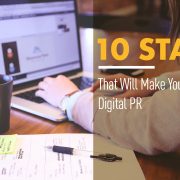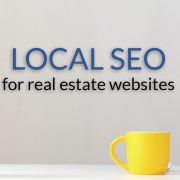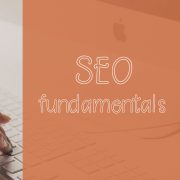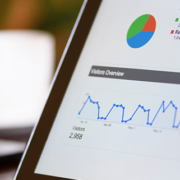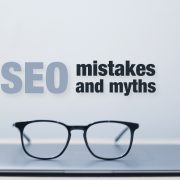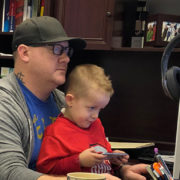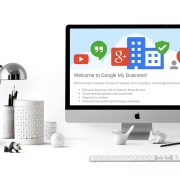3 Pillars of SEO Success
The three pillars of SEO Success are local, on-page, and off-page.
-
What I want to preface with is that; this is our strategy, this is based upon years of our experience, how we do things here at iSynergy, and the level of success we’ve seen. We do a lot of testing here, but I’m going to tell you we follow quite a bit from industry leads; Brian Dean, Neil Patel, and Backlinko. That information is then aggregated and used with our clients here at the agency.
SEO, as with any marketing tactic needs to start with a goal first. So depending upon your type of business, the goals for SEO might be a lot different. If you don’t have a brick & mortar, if you’re a service company, if you are a service company that has a brick & mortar. There are many types of businesses, and each type has different goals and various strategies. Many times it takes a bit of research to see what the best option is for your type of business.
We start with a strategy, we then optimize, test and we discuss the success, touching all of our campaigns weekly. If you’re moving forward with a certain strategy and you’re not seeing the results, you need to pivot. There are some general best practices that you’re going to use, such as go heavy on content, get more inbound links, edit your anchor profile and fully fill out your Google My Business (GMB). There’s a lot of things to go and do. There’s always going to be a “yeah BUT what about my case..” so on and so forth. So let’s get started.
1. Local SEO
We always start here with local, it’s the foundation, the basis for everything else. You can have thousands of inbound links and great content that you have optimized on your site, but if you are not optimized for local search results you’re going to have that ceiling on your goals (plus it’s easiest and it’s the cheapest.) Many times we do this for clients but a lot of times clients just do it themselves, we give them a game plan and we say “here, go and execute.”
NAP
-
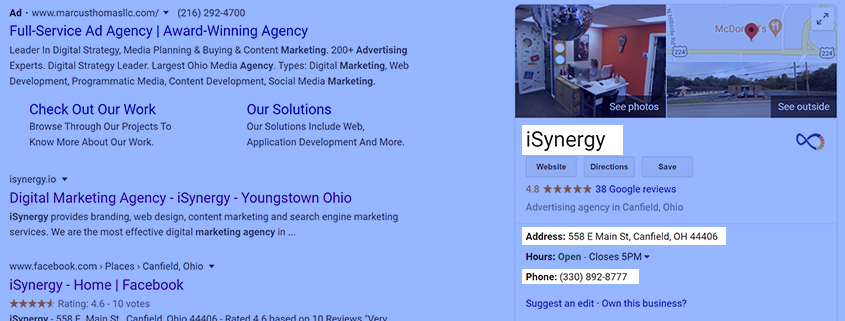
NAP stands for; Name, Address, Phone number. Every time you have your company listed with a consistent NAP on a directory such as Axium, Facebook, Foursquare, a regional chamber website, that’s called a citation. The more consistent citations you have for your company the better, as citations are like votes, the more citations you have the higher you’re going to rank.
In order to do that, you fully need to fill out your Google my business profile (GMB) including your short name. Creating a short name is a great way to connect with your customers with Google Maps. You use this link on your location pages and social accounts. A lot of people rushed to get their short names, there’s a lot of brands and there are singular short names for the entire world. We had some clients that have competing brands in Europe, Australia, Canada and even the next state over. So you want to make sure that you’re going out and properly claiming that short name.
We did ours obviously, we did our brand iSynergy, which you can get tricky with it if you don’t want to do your brand, you can do your service or a combination of your brand and service. There are different strategies to move forward with, but at this time, it just rolled out within the last few months. With Google who knows how long it’s going to last, who knows how much priority, they could even depreciate it next month or five years from now. Here at my firm, Google rules our world, as 85-87% of search volume is done on Google. That’s why everything I’m talking about here is focused on Google.
With your NAP, you also need to make sure that you choose the proper category. Facebook, GMB, Yelp, YP all allow you to do it. If I am a, let’s just say I’m a home inspection company, don’t categorize yourself as a financial institution.
With your NAP, sometimes it’s just about proximity. If somebody is doing a mobile search and they’re thirty steps away from one of your highest competitors and you’re five miles away, chances are that you’re not going to be able to out-rank them in that situation. You can get as close as you can, but you need to know that some goals need to be realistic, you’re not always going to be able to jump higher than everybody.
Reviews
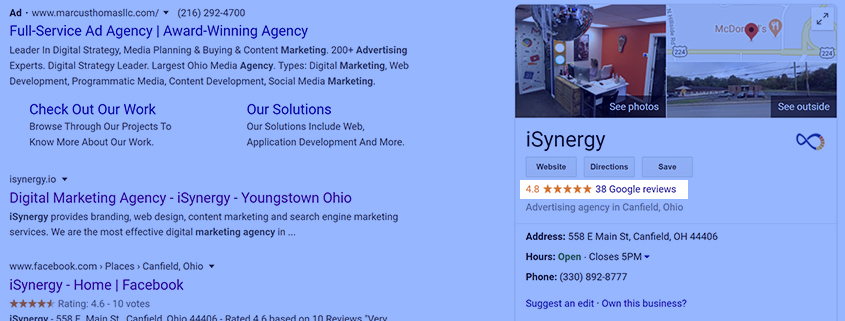
So the first thing with local is your NAP, your citations, next thing is your reviews and everybody hates them. You have to have them though, it’s awkward, you hate asking for them, you hope when you do, they’re good. But if you’re doing a good job in your business and you’re delivering a quality product or service, you should be able to aggregate those reviews and get people to give you those reviews.
With that being said, it’s not just on Google, those reviews should also be on your social sites; when you search GMB your knowledge card on the side of a Google cert page brings in Facebook reviews right into that knowledge card. So you want to make sure you find your niche of review sites, there are hundreds of review sites out there, so make sure you are requesting those reviews and you’re monitoring those reviews. If you have a bad review, own it, ask them what you can do, what you did wrong, what you can do to improve that review. It’s customer service for the new age. If I have two reviews and they’re both one-star reviews and my competitor has fifty reviews with an average rating of 4.9 obviously Google wants to show my competitor because they have many more reviews and the review rating is higher.
This is an indicator that Google takes into account when delivering on a SERP. You are judged on the quantity of them and how fast you get them. One thing to always know is there are paid review services where you pay people to give you your reviews. As for the velocity, if you go from three reviews over ten years and next week you get fifty, Google is going to put you on their radar, they might not black flag you however, you’re going to be on their radar so you need to watch the velocity. If you have one hundred clients that you know are going to give you good reviews, start an email campaign, send 10 a week, don’t send all one hundred saying “hey let’s get them as fast as we can,” pace it out. You want to make it look organic as Google has confirmed that,
“Contests to generate reviews are a violation of policy. Our policy states that businesses should not solicit reviews from customers in bulk.”
Social
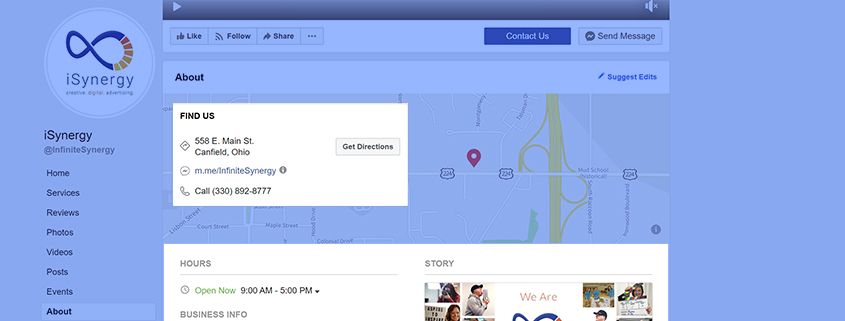
- Make sure you have all of your business information on your social profiles. Make sure number one; you have your social profiles claimed, even if you actively manage your social media on your own, still claim your profiles, and update the “about” information. We do it for brand protection but it also helps as it’s considered a Local SEO citation. They take into account the number of followers, likes, times you’re tagged, the engagement on your posts, so being active is important. All of this takes time and it’s not just a one-time set it and forget it.
-
Images -
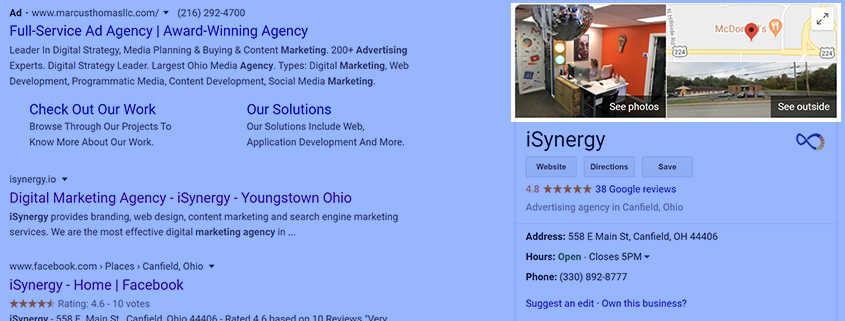
- You want to put up both interior and exterior images of your brick and mortar. Google usually pulls those in but you can upload your own as well. Take pictures of your staff, products, take pictures of anything and everything. Think of GMB as a social site. Google did depreciate Google+, but there are a lot of features from Google+ that are now popping up in the road map for GMB. So think of it like that and stay with it. Also, public patrons can submit their own images as well; so you want to be abreast of that.
-
BehavioralLastly for local, behavioral. Behavioral is the “user experience” such as click-through rate (CTR). If you’re getting shown all the time on SERP results like a mobile SERP result in the local pack and you’re never getting clicked on, Google is going to start to think, “wow, nobody likes this company, nobody wants this company, we’re serving it up for the wrong keywords” because Google’s intention is to give the consumer, the searcher, what they want and what they think that they want.
It’s not to manipulate the search for the consumer, it’s to deliver to them what they think they want. So if you’re showing up ten times last month for a certain keyword and your link got clicked on all ten times, that shows intent, that’s your CTR. When this happens, searchers are going to start being served your listing for more of those keywords and LSI’s that go along with keyword synonym-type words.
This is nothing that you can manipulate and it’s nothing you have control over. Well you do – but indirectly. These are some things you need to be aware of when it comes to the click-through rate.
Secondly, mobile click to call. If you’re on your phone and you look a business up then click on the “click to call” button, Google sees that as intent, it was a proper way to serve up your business for a proper keyword.
Check-ins. Mobile check-ins to your location on social. GMB can now offer incentives with the GMB posts. So the more engagement you get on those posts the more offers come along. That is in a nutshell the foundation of SEO for my company, our agency, where we start from everything and the things we take into account. We have to start from it in order to build that foundation for SEO success.
2. On-Page SEO
On-page SEO is closely tied to inbound marketing. So every page on your website should be centered and focused on a single, major keyword. You should not try to build out your content, for a webpage, around five different major keywords if they aren’t closely related, that is. So define a major keyword for a single page. So everything we talk about is for a single page, it’s not for your entire website, it’s not for just your blog, we’re talking about just your homepage or we’re talking about a single product page on an ecommerce cart.
Page hierarchy: <title>, <h1>, <h2>, <h3>, <meta>, <alt>

Major Keyword
You want to use a major keyword in the title of the website. Some of these things are a little technical so if you’re not familiar with web development, this is literally on your website code. If you use WordPress there’s a Yoast plugin that will help you do a lot of this, so depending on your CMS there’s different ways to manipulate this. Shopify also allows you to do some good on-page SEO. As for Squarespace, people come to us a lot of times and they have a Squarespace website, which they look great, they convert, they do a lot of good things, but if you want to take your marketing to the next level when it comes to SEO, you can’t as they don’t allow you to access the code.
Mostly things I’m talking about are going to be code-based. For example if I am a locksmith, my major keyword could be obvious, “locksmith”. I want to use the word “locksmith” in the title of my homepage, in the <h1> of that page, on the <alt> tag, and the file name of the very first image. Also note that it’s best practice, to use the major keyword in the first hundred words of your copy as well as in the final hundred words of that webpage copy. For example, modifiers such as “best”, “guide”, “review”, “2019”. Those are all modifiers that you want to use with your keyword to make them more relevant in the search. People don’t do that enough and they don’t get creative enough with those keywords.
The major keyword shouldn’t be brand-focused, and I’ll use my own company to explain this to you, my homepage is optimized around my brand, iSynergy. The reason for that is, we tell clients never do this because you want to optimize around a product or service, you don’t want to optimize around your brand. In our case, we needed to because, at the time when we were first founded back in ‘08, there were two other iSynergy’s in the country. So when somebody searched iSynergy I wanted to make sure our brand was the strongest and ranked the highest. But, for DOYO, the conference, there’s no other DOYO in the United States. So why optimize and have your keyword be DOYO on your homepage when nobody is really searching for that. It will come organically if you optimize around all your other keywords. If DOYO is the name of your company, it will automatically show up if there’s not competing companies with the same name. So one thing to think about; you don’t optimize around your brand name. It’s just bad practice unless there is a real reason as in our case that I gave you, that’s why we did it.
<title> tag
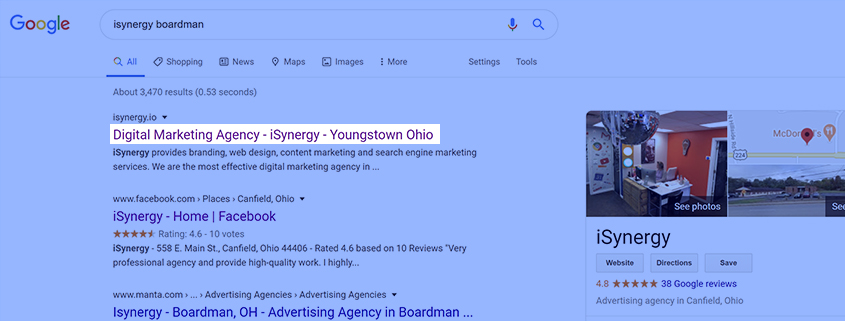
Title tag, this changes from time to time but should be around fifty-five to sixty characters, (six hundred pixels), nobody understands pixels, so we say characters. This needs to be in the first tag in the heading area, if you’re familiar with the code. If at all possible try to start the title tag with the major keyword. For example with DOYO marketing conference – an idea for a title tag; best marketing conference to talk about inbound marketing, inbound marketing is at DOYO conference. You want your major keyword, which would be “marketing conference” to be toward the front of that title tag and not towards the end. You always want to push it closer to the front. Then we went over the modifiers like; “2019”, “best”, “highest rated”. All those modifiers can use the localization; “Youngstown”, “local”, “Ohio”, “Columbus”. Use those modifiers as much as possible.
<h1> tag

Best practice was that your h1 should be exactly the same as your title tag. But, now that Google is better with LSI and synonyms you don’t need to make them exactly the same and actually you get a negative effect if you have them exactly the same. So now you need to have your major keyword in the h1 but you want it to be an LSI, Latent Semantic Index. If I am optimizing my page around coffee, Google understands that if you use the keywords; “filter”, “brew”, “cold-brew”, “decaf”, those are all LSI’s. They’re synonyms of words that go with coffee, so you don’t need to use “coffee”, one hundred and fifty times when you have a page that only has seven hundred words on it.
When it comes to h1’s previously you could only have one h1 per page as this would negatively impact your ranking with Google. Now you can have two or three and you don’t get that negative impact. We haven’t found that it actually improves but we are seeing that it does not drop you. I would highly suggest that you don’t go over three.
<h2> tag
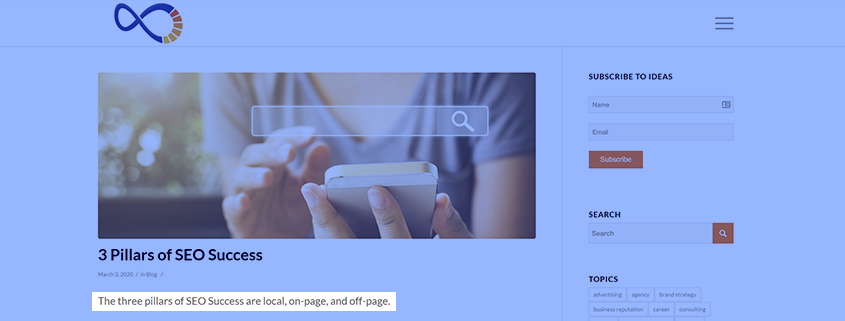
We always say three to five per page. The h2’s are supporting- and these would be those LSI’s, like say we have that same coffee page. H2’s are descriptive words around your pillar keyword, which would be coffee. For example, decaf coffee or cold-brew. Then h3’s are just descriptive words about your h1’s and your h2’s. So you can see the hierarchy. You have your major keyword that defines your page that you use as your title (as close to the front as possible). You add some modifiers, then you have your h1 (using your major keyword synonym or even a reworded version of the title.) Then you have your h2’s that support your h1’s, then your h3’s that support your h2’s.
<meta> tag
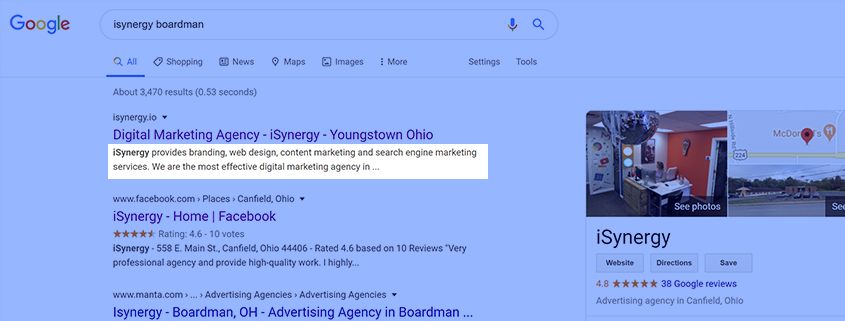
Meta description has zero SEO value. But, why do we put it on here? Because it’s user intent. The title in the Google search result is literally the blue text that you click on, so if you have a Google search result page with ten listings on there, the blue text that you literally click on that’s the title of the page; you don’t see, h2’s, h3’s (except for in the code). However, the meta description is the normal black font text that is underneath the blue link, that’s called a meta description. It used to have some SEO value but now it has zero SEO value. But, what do you do when you Google something? You look at the listings and then you read that copy and that text right underneath the listing, right? So it has some value when it comes to a user experience and click-through rate. We still optimize for it but it’s less around keywords and it’s more around user intent. We say stay between, for a desktop, one hundred and fifty to one hundred and fifty-five characters. For mobile, stay under one hundred and twenty characters. You want it to read naturally, don’t just put keywords in there. You want to make sure it has the pages major keyword because Google will highlight that and bold it in the results but don’t just stuff and repeat keywords.
<alt> tag
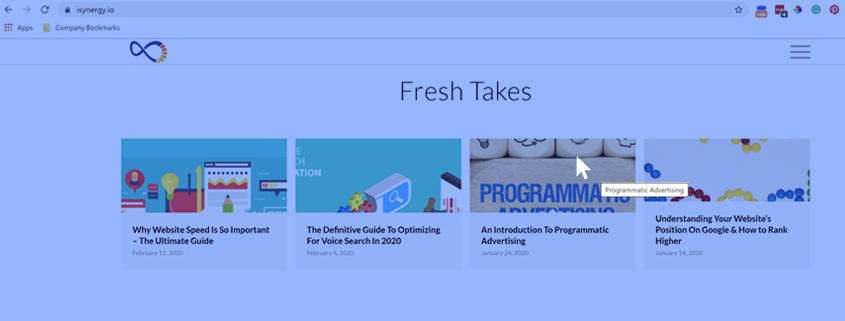
Alt tag is when you’re on a website and you hover over an image, don’t click on it, but you hover over it and some text pops up. That is the alt tag. It tells screen readers (those used by the disabled) what that image is about. So you need to optimize on that alt text.
You want to make sure that the major keyword that you defined for that page is in the very first alt tag of that page. There’s no length on those but you want to keep it shorter rather than longer, longer looks like keyword stuffing.
Google bots now scan your file names that are on your website. So that image that you’re seeing on a webpage or that you created, it has an alt text that you’re force feeding Google to read but then also there’s that image file name. So you don’t want to have an alt text of a coffee image and then the file name for that image to be “Stock Photo #3”. Which none of the 99% of the digital world does. Our best practice here, in my agency, is that the alt text exactly matches the filename; in WordPress, you would do that in your media library. Basically every CMS has a media library where you put things, just make sure you’re naming them properly and have a naming convention that you mimic on your alt tags as well.
Schema
If you’re trying or thinking about SEO and you’re not following schema you need to jump on board real fast. Schema is a set of code that you can force feed Google; the company logo, business hours, and the address. Now to bring things full circle, when you’re using schema in the address, you want to make sure that address matches exactly to your local SEO, (your NAP that we talked about earlier.) There are over a hundred different tags available in schema markup code so you’re not just relying on Google to translate and understand it.
Load Time

What’s the goal? You want it to load in under two seconds for mobile and less than three seconds for a desktop website. You can do everything right but if you have junk servers that you’re hosting on your load time is going to lag – literally you get what you pay for. Make sure you have your images are compressed properly and you don’t have plugins like that are bogging your site down with bloat. This indirectly increases your bounce rate because people aren’t going to wait seven seconds for your site to load while they’re trying to find something.
“Everybody’s a goldfish these days.”
-Steve Cross

You need to get it to them right now and you need to capture their attention or they’ll leave, especially on mobile.
With mobile, you don’t have control over their network, their speed of their network, whether they’re on wi-fi, or just on their data plan but control what you can control. Properly set up your site, there used to be mobile versions, now it’s all responsive. You need to audit your responsive site. You need to audit your desktop site and strip out those images. We just did a site for a client where 90 percent of their traffic was coming from mobile, so we developed their website on mobile first to give the users what they wanted.
What do you need to answer on a mobile website right off the bat? Phone number, address, contact form, what are you about, what do you do, how can I get to you. Then on a desktop website you can expand on it.
That’s everything for on-page technical SEO. This is usually the hardest part for people to grasp because most marketers don’t understand or they have very limited knowledge of the technical components of the code which is where a lot of these things live.
3. Off-Page SEO
It’s the smallest portion that’s probably the most difficult thing to do, off-page, which is basically inbound links. Every website on the internet has a score, domain authority (DA.) So the more inbound links your website has the better, that’s a pretty broad stroke but you want your inbound links to be from highly populated and from high domain authority websites. So if I have ten thousand inbound links and they’re all from local websites that get like five sessions a month, that really doesn’t mean anything. But, if I have five inbound links and those links are USA Today, ESPN, all ninety’s from a DA standpoint, those links mean a lot.
When I talked about citations and those looking like votes and the more votes you have the better; inbound links are exactly the same but there are ratings of those inbound links. Citations are all created equal, it’s just a directory listing, they all matter the same. Inbound links, like I said every website has a domain authority from zero to one hundred; Google and Amazon are like a ninety-nine and Yahoo is like a ninety-seven. So the higher, you get an inbound link from a higher DA the more juice it pushes to your site. So you need to have inbound links.
The way to get those is probably a whole webinar series in itself. But, you need inbound links and you need to get them from high authority websites. That being said, you have to watch your anchor profile, an anchor is the text that you click on to go to another page or to another site. That text, whether it be the company’s name, whether it be just the word “here” or whether it’s just their website; that is called your anchor text. Google takes into account a lot with your anchor text.
You never want to over-optimize your anchor profile for exact match keywords, never want more than three percent of any of your inbound links to be an exact match. For my company, it’s like; marketing agency, SEO agency, blah blah blah. So we never want to over-optimize, when you over-optimize then you get on Google’s radar, you don’t want to get on Google’s radar because then they’re going to start pushing you down in the rankings.
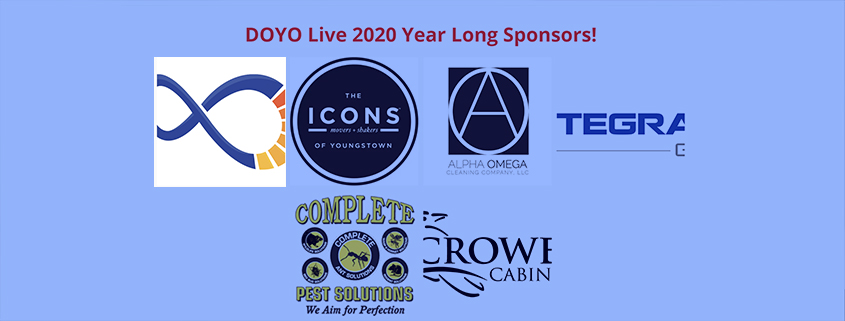
Guest post, if you hear a lot about a guest post, that’s an inbound link strategy. A lot of different things like that; are manual outreach, there a lot of different ways you can get those inbound links. Sponsorships; we have an inbound link, iSynergy does, from DOYO because we’re a sponsor. Dennis put a link from his website over to our website, so that helps us. There’s a lot of different ways to acquire those links. That’s off-page in a nutshell, it’s the hardest, it’s the most time-consuming, it has the most value. Each one of those you’re going to go down a rabbit hole.



